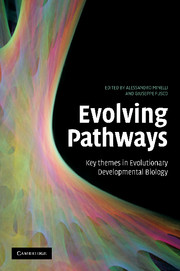Book contents
- Frontmatter
- Contents
- Contributors
- Preface
- Introduction: Pathways of change
- Part I Thinking about evolution by taking development on board
- Part II Evo-devo: methods and materials
- Part III Evolving diversity
- 12 Unravelling body plan and axial evolution in the Bilateria with molecular phylogenetic markers
- 13 Are transposition events at the origin of the bilaterian Hox complexes?
- 14 Many roads lead to Rome: different ways to construct a nematode
- 15 Basal euarthropod development: a fossil-based perspective
- 16 Developmental transitions during the evolution of plant form
- Part IV Evolving body features
- Index
- References
16 - Developmental transitions during the evolution of plant form
Published online by Cambridge University Press: 08 August 2009
- Frontmatter
- Contents
- Contributors
- Preface
- Introduction: Pathways of change
- Part I Thinking about evolution by taking development on board
- Part II Evo-devo: methods and materials
- Part III Evolving diversity
- 12 Unravelling body plan and axial evolution in the Bilateria with molecular phylogenetic markers
- 13 Are transposition events at the origin of the bilaterian Hox complexes?
- 14 Many roads lead to Rome: different ways to construct a nematode
- 15 Basal euarthropod development: a fossil-based perspective
- 16 Developmental transitions during the evolution of plant form
- Part IV Evolving body features
- Index
- References
Summary
THE INVASION OF LAND
Land plants evolved from aquatic algal ancestors. The algae are a polyphyletic group from which the transition to land, and acquisition of developmental features associated with land plants, have occurred many times (Lewis and McCourt 2004). Recent phylogenetic evidence points to the charophyte algal lineage as the sister group to the land plants (Figure 16.1). Developmental features shared by charophytes and land plants are cell cleavage by phragmoplasts, plasmodesmatal connections between cells, and a placental link between haploid and diploid phases of growth (Marchant and Pickett-Heaps 1973). These and other features of derived charophytes, in particular growth from an apical cell in the gametophyte (Graham 1996, Graham et al. 2000), suggest that many of the cellular characteristics required for the development of land plants may have evolved within their common stem group.
FROM HAPLOID TO DIPLOID
The major character that distinguishes land plants from charophyte algae is the development of a diploid embryo. In charophytes, the majority of the life cycle is represented by the haploid gametophyte and only the unicellular zygote is diploid, undergoing meiosis immediately after formation. Embryo development represents a major growth transition in that meiotic division of the zygote is delayed and diploid sporophytic cells divide by mitosis, giving rise to a multicellular body. Although in the earliest land plants the gametophyte generation remained dominant, this transition in growth pattern led to a dramatic change in life history such that the sporophyte generation gradually became the dominant form (Graham 1985, Kenrick 1994, Graham and Wilcox 2000).
- Type
- Chapter
- Information
- Evolving PathwaysKey Themes in Evolutionary Developmental Biology, pp. 299 - 316Publisher: Cambridge University PressPrint publication year: 2008
References
- 14
- Cited by



